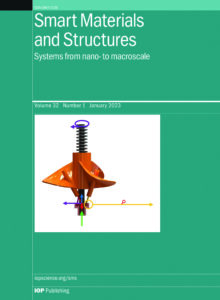SMS特刊征稿|聚焦非线性材料和结构的智能传感、建模与分析

特刊详情
客座编辑
- Hewenxuan Li(李贺文轩),Cornell University(美国康奈尔大学)
- Rui Yuan(袁锐),Wuhan University of Science and Technology(武汉科技大学)
- Somdatta Goswami,Johns Hopkins University(美国约翰斯·霍普金斯大学)
- Qianying Cao(曹倩影),Brown University(美国布朗大学)
主题范围
Advances in novel material manufacturing and design increasingly leverage inherent material and structural nonlinearities to achieve system stability and multiple operational modes with minimal input energy to the system. The multifaceted nature of nonlinear materials and structures, exhibiting phenomena such as multi-equilibria, multimodal responses, hysteresis, and chaos, demands rigorous analytical, numerical, and experimental methodologies for analysis. Robust observation or sensing techniques become essential when the system under investigation is nonlinear, which affects the downstream data analysis and modelling for experimental explorations. Traditional kinodynamic modelling of complex nonlinear systems becomes increasingly challenging, necessitating the development of plausible and reliable reduced-order models for dynamics and control. These models enhance computational efficiency and facilitate real-time applications in modelling, predictive maintenance, and control.
Recent advances in deep neural network architectures have demonstrated unparalleled performance in augmented sensing, surrogate modelling, and uncertainty quantification for nonlinear materials and structures. Techniques such as physics-informed machine learning, deep neural operators, and deep state space models show promise in surrogate modelling, state forecasting, and model-based control of structures and robots. Additionally, deep generative models and large language models enable intelligent generative design, sensing, uncertainty quantification, and predictive maintenance based on extensive historical datasets.
This special issue aims to explore and exploit state-of-the-art intelligent sensing, modelling, and analysis techniques for nonlinear materials and structures. Topics of interest include, but are not limited to:
➢ Intelligent observer and sensor design
➢ Surrogate material constitutive model
➢ Data-driven modelling for nonlinear systems
➢ Deep neural operator for nonlinear materials and structures
➢ Physics-informed machine learning for nonlinear materials and structures
➢ Intelligent diagnosis and prognosis of mechanical, civil, aerospace and aeronautic structures
➢ Intelligent control of novel materials and structures
➢ Generative design of smart materials and structures
➢ Intelligent sensing, modelling, and control for biosystems and robots
➢ Uncertainty quantification in sensing, modelling and design of materials and structures
投稿流程
特刊文章与SMS期刊常规文章遵循相同的审稿流程和内容标准,并采用同样的投稿模式。
有关准备文章及投稿的详细信息,可以参阅IOPscience页面的作者指南。
作者可登入期刊主页进行在线投稿,先选择“文章类型”,然后在“选择特刊”的下拉框中选择“Intelligent Sensing, Modelling and Analysis of Nonlinear Materials and Structures”。
期刊介绍

- 2023年影响因子:3.7 Citescore:7.5
- Smart Materials and Structures(SMS,智能材料与结构)是一本多学科期刊,专注于智能材料、系统和结构(包括智能系统、传感和驱动、自适应结构和主动控制)的技术性进展。SMS内容涵盖:智能材料开发和应用;用作传感器和驱动器的智能材料;自适应结构系统;用于修正光谱偏移和折射率偏移的智能光学材料;用于地面车辆、飞机和民用基础设施;能源收集系统;利用仿生学和生物灵感的智能材料系统;3D打印智能材料及其应用;智能纺织品和可穿戴技术等。
